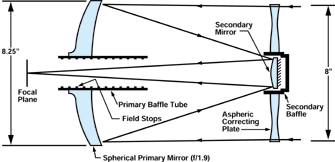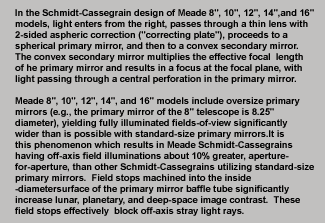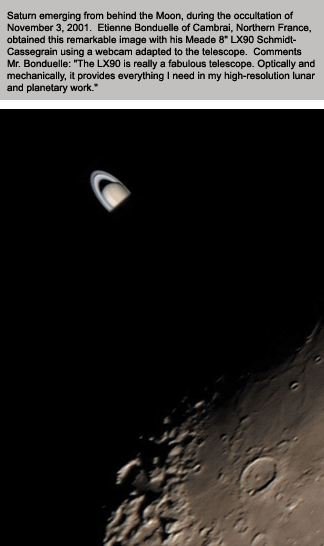 |
| |
|
Meade 7", 8", 10", 12", 14", and
16" LX-Series Telescopes
|
|
|
|
|
|
Diffraction-limited
Schmidt-Cassegrain
and
Maksutov-Cassegrain
optics, assembled
into advanced
electromechanical
systems.
The large apertures
of Meade LX-Series
catadioptric
(mirror-lens)
telescopes permit
the use of higher
observing
magnifications than
is the case with
smaller instruments,
and because of the
telescopes' greatly
increased resolution
and resolving power,
extremely fine
celestial detail may
be observed and
photographed. The
four principal
satellites of
Jupiter become
finite-sized orbs
rather than
pinpoints; the
planet itself, under
favorable
atmospheric
conditions, is an
intricate web of
whirls, festoons,
and discontinuities.
Saturn's rings
resolve into finer
detail, with at
least 3 rings
observable, and with
detectable color
variations. Six of
Saturn's satellites
are visible in
revolution about the
planet. Numerous
features of the
Martian landscape,
including the white
polar cap, are
clearly
identifiable. The
Moon is a veritable
treasury of
incredibly fine
fault lines,
craterlets, and
rilles. Deep-space
phenomena take on a
new character when
explored through the
tremendous light
gathering capability
of the 7", 8", 10",
12", and 14" models.
Galaxies merely
visible in smaller
telescopes begin to
show their essential
structure; globular
star clusters are
resolvable in fine
detail, in some
cases to the core of
the cluster; diffuse
gas clouds such as
the Orion Nebula are
visible in such wide
extension that the
nebulosity may fill
the field of view.
This listing only
hints at the breadth
of galactic and
extragalactic
objects visible
through the eyepiece
of a Meade 8", 10",
12", or 14" SCT or
7" MCT model: it is
a rare observer who
might in a lifetime
view all of the
enumerated phenomena
in the above
categories.
Meade
Schmidt-Cassegrain
Optics: In
astronomical optics
the term
diffraction-limited
is used to rank an
optical system as
being of
professional
quality. Simply put,
diffraction-limited
means that the
performance and
resolution of an
optical system are
limited only by the
size of the
theoretical stellar
diffraction image -
i.e., limited only
by the inherent
aperture of the
system and by the
laws of physics.
Meade hand-matched
and hand-figured
Schmidt-Cassegrain
and
Maksutov-Cassegrain
optical systems - in
continuous,
independent, random
tests by advanced
amateurs and in
definitive test
reports |
|
|
"Over the past
few days I have put
my new 10" LX200GPS
through exhaustive
testing, optically,
mechanically, and
electronically. My
conclusion is
simple: this is
without question the
most advanced
amateur telescope I
have yet used (and I
have used many), an
elegant and
important evolution
of the LX200 I
previously owned. In
terms of pointing
precision, optical
resolution,
electronic
sophistication, and
almost every other
significant feature
one could imagine —
not to mention ease
of use — the
telescope is simply
miles ahead. I have
tried hundreds of
slews to objects in
the database and
every one ended up
with the object
pinpoint-centered in
the field...The
value of the
microfocuser is
difficult to
overstate: images of
the Moon and
Jupiter, for
example, are very
tightly focused;
extremely precise
focusing in both
visual and CCD
applications is now
easy to accomplish.
GPS alignment is
very accurate and of
real assistance in
getting the scope up
and running quickly
each night. For CCD
imagers like me, the
primary mirror lock
has finally, and
completely, resolved
the issue of mirror
shift during
focusing...This is
just a magnificent
astronomical
instrument."
- John E.
Hoot, San
Clemente, CA.
|
|
|
|
by leading
astronomical
magazines - are
consistently ranked
as
diffraction-limited.
That Meade
Schmidt-Cassegrain
and
Maksutov-Cassegrain
optics carry such a
reputation worldwide
is perhaps the
prospective
purchaser's best
assurance of optical
quality.
Astrophotography:
Many Meade
Schmidt-Cassegrain
owners have done
fine,
high-resolution
photography of the
Moon, planets, and
deep-space, as the
photos on these
pages confirm. A
large complement of
optional accessories
is available for
virtually every type
of photographic
application.
|
|
CCD Imaging:
Creating a multifold
increase in the
effective aperture
of any Meade
telescope, CCD
imagers enable the
imaging of the
planets and
deep-space objects
with a level of
resolution and
detail therefore
impossible to
achieve. Many of the
finest astronomical
images in this
catalog were
obtained with a CCD
imager.
|

|

|
|
|
|
|
Meade LX10, LX90,
and LX200GPS
Schmidt-Cassegrains:
Meade
Schmidt-Cassegrain
telescopes include a
wide range of
features and
specifications,
permitting a choice
of telescope
precisely tailored
to each buyer's
requirements. The
tube assemblies of
LX10, LX90, and
LX200GPS models
utilize identical
optical systems.
Differences among
the various models
lie primarily in the
relative levels of
mechanical and
electronic
sophistication.
Detailed
descriptions of all
models will be
presented later;
basic model concepts
are as follows:
|
|
|
|
8" LX10
Schmidt-Cassegrain:
Responding to the
demand for a
relatively light
weight,
moderately-priced 8"
Schmidt-Cassegrain,
the Meade 8" LX10 is
nonetheless fully
qualified as a
serious instrument.
The LX10 operates
for about 50 hours
from its internal
battery-powered
motor drive system.
The
standard-equipment
hand controller
enables precise 2x
guiding corrections
in Right Ascension
during long-exposure
astrophotography;
corrections in
Declination may be
effected from the
same hand controller
by adding the
optional Declination
motor. |
|

|
8" LX90
Schmidt-Cassegrain:
Announced in June,
2000, the Meade 8"
LX90
Schmidt-Cassegrain
is the first
full-capability,
computer-controlled
8"
Schmidt-Cassegrain
ever offered in its
price range — a
telescope that
includes many
advanced features:
Dual-Axis
worm-gear drive
system: With
4.9"-diameter gears
for smooth
sidereal-rate
tracking and
slewing, the LX90's
microprocessor-controlled
drive system allows
for precise
long-exposure
photographic or CCD
imaging.
Autostar
Computer Controller:
Use Autostar to GO
TO any of over
30,000 celestial
objects in the LX90
database or to any
object of known RA
and Dec.,
automatically, at
the push of a button
and at a speed of
6.5°/second on both
axes,
simultaneously. The
telescope's pointing
precision is a
remarkable 5-arc
minutes or better.
|
|
|
|
|
|
|
Die-cast
aluminum,
double-tine fork
mounting: The
LX90's fork mounting
yields all of the
rigidity required
for advanced
applications of the
telescope, from
high-power,
high-resolution
visual observing of
the Moon and planets
to long-exposure
astrophotography or
CCD imaging. A
3-connector control
panel is integrated
to one of the fork
arms.
Variable-height
Standard Field
Tripod:
Consistent with the
mechanical standards
of the LX90 system,
the chromed-steel
Meade Standard Field
Tripod (the exact
same tripod included
with Meade 8" and
10" LX200GPS models)
provides rock-solid
support for the
telescope.
Cordless
operation: Power
the telescope from
eight
(user-provided)
C-cell batteries
located internal to
the telescope's
drive base.
Nine
selectable slew
speeds: Push the
Autostar speed
button to change
dual-axis speeds
from a slow 1x
sidereal to a fast
6.5°/second in any
of nine increments.
8" and 10"
LX200GPS
Schmidt-Cassegrains:
Meade 8" and 10"
LX200GPS
Schmidt-Cassegrains,
announced in
September, 2001,
present to the
serious amateur
instruments ready
for an amazing array
of state-of-the-art
capabilities. Built
into the new
LX200GPS fork mounts
— the strongest,
most rigid mountings
available on
Schmidt-Cassegrains
of these apertures —
is one of the most
advanced electronic
packages ever
offered, at any
price, in a
commercial
telescope, an
electronic package
that makes using
these telescopes a
revelation, for the
beginner or for the
most experienced
observer. Imagine
being able to select
any of over 145,000
celestial objects —
objects |
|
|
|
that include entire
catalogs of
galaxies, nebulae,
star clusters,
double stars, and
variable stars, as
well as all eight of
the major planets
from Mercury to
Pluto — and, at the
push of a button,
having the telescope
automatically move
to the object and
center it in the
telescopic field to
a precision of
within arcminutes.
|
|
|
|
Meade LX200GPS
models perform such
feats of pointing
precision time after
time, on object
after object,
enabling the user to
observe or
photograph extremely
faint galaxies, for
example, at the very
limit of the
telescope's
capability, knowing
that the object is
precisely located at
the telescope's
field center. In
addition dozens of
telescope functions
— from changing slew
speeds to automatic
GO TO — can be
actuated from the
Autostar II hand
controller.
12" and 14"
LX200GPS
Schmidt-Cassegrains:
The large
light-collecting
apertures of Meade
12" and 14"
Schmidt-Cassegrains
extend the serious
amateur's ability to
engage in a wide
range of significant
astronomical
research, from
variable star
observing to
planetary study and
supernova imaging.
Combining the
LX200GPS package of
advanced electronics
and precise
automatic GO TO
object-location with
large, extremely
rigid fork
mountings, Meade 12"
and 14" models
present an amazing
level of detail and
resolution in the
solar system and in
deep-space.
|
|
|
16" LX200GPS
Schmidt-Cassegrain:
Now installed in
hundreds of school
and college
observatories, as
well as those of
advanced amateurs,
around the world,
the Meade 16"
LX200GPS is the
largest
Schmidt-Cassegrain
telescope currently
in production. For
the advanced amateur
who can appreciate
what a
research-class
|
|
|
|
"Here at the
Arkansas Sky
Observatory we use
Meade telescopes
nightly for the
highly sophisticated
ASO Sky Patrol
program, which, in
addition to routine
monitoring of Mars
and Jupiter, does
very precise
astrometric and
photometric
observations of
literally hundreds
of objects monthly.
Our observations are
used routinely by
planetary
observatories and
the American
Association of
Variable Star
Observers; our comet
and asteroid
observations number
in the thousands and
we have been
assigned Harvard
Minor Planet Center
observing codes H41
and H43. Our work
involves the
monitoring of no
fewer than 18 comets
and many cataclysmic
variable stars,
objects which
require multiple
determinations each
night. This regimen
would be virtually
impossible without
the highly accurate
GO TO capability and
precise tracking of
our Meade 12" and
16"
Schmidt-Cassegrains.
On occasion we take
as many as four
readings of each
object in one night,
sometimes resulting
in over 140 CCD
images with the 16"
telescope of objects
as faint as
20th-magnitude.
These objects, and
the very small star
fields in which they
are located, can not
even be seen
visually, and we
rely completely on
the accuracy of the
telescope's GO TO
pointing to locate
them. I might add
that the magnitude
reach of the
telescopes,
especially important
in our studies of
faint comets,
asteroids, and
near-Earth objects,
has been
dramatically
augmented in our
dark mountain skies
with your new UHTC
coatings...All four
of our Meade
telescopes will
access a faint comet
after a slew
completely across
the sky and position
it near dead center
on the CCD chip,
allowing us to see
each acquired field
on television
monitors. Such
acquisition is made
possible by the
precision of the
Autostar's GO TO.
The ease of
|
|
|
|
coupling our LX200 and
LX200GPS telescopes
to personal
computers enables us
to control the
telescopes, from
Autostar programming
to focusing of the
image, remotely via
computer...The
technology in Meade
LX200GPS telescopes
provides to the
amateur what was
totally unavailable,
and probably
unthinkable, even to
the professional
astronomers of 30
years ago when I
began my study of
astronomy. Your
company has opened
the door for serious
amateur astronomers
to perform dedicated
research."
- Dr. P. Clay
Sherrod, Arkansas
Sky Observatory,
Morrilton, Arkansas
|
|
|
|
|
|
instrument can bring to his or
her observing
program, or for the
school or college
astronomy department
seeking a
first-class teaching
telescope, the Meade
16" LX200GPS is
without equal. As
imaging tools, Meade
16" LX200GPS
Schmidt-Cassegrains
have been
responsible for some
of the most
impressive results
ever obtained by
amateurs or
professionals.
7" LX200GPS
Maksutov-Cassegrain:
The Meade 7"
LX200GPS
Maksutov-Cassegrain
exploits fully the
extraordinary
imaging
characteristics of
the Maksutov design.
Housed in a compact
optical tube
assembly, the Meade
7" Maksutov optical
system rivals the
optical performance
of even a fine ED
apochromatic
refractor, and,
mounted aboard the
awesome
electromechanical
capabilities of the
Meade LX200GPS fork
mounting, the
telescope is a
formidable
astronomical tool.
Equatorial Wedges:
For placement of
Meade LX200GPS
models in the
equatorial mode
during long-exposure
CCD imaging or
photography, three
equatorial wedges
are available: the
Standard Equatorial
Wedge for 8" Meade
SCT telescopes; the
10"/12" Superwedge
for 10" and 12"
LX200GPS models; and
the 14" Superwedge
for the 14"
LX200GPS.
Field
De-rotaters:
With the optional
Meade #1220 Field
De-rotater, field
rotation during
long-exposure
photographic imaging
with Meade LX200GPS
models in the
altazimuth mode can
be fully and
precisely
compensated for,
without recourse to
an equatorial wedge.
|
|
|
|
|
|
|
|
|
|

